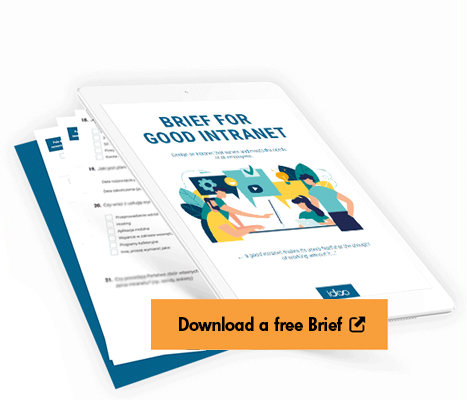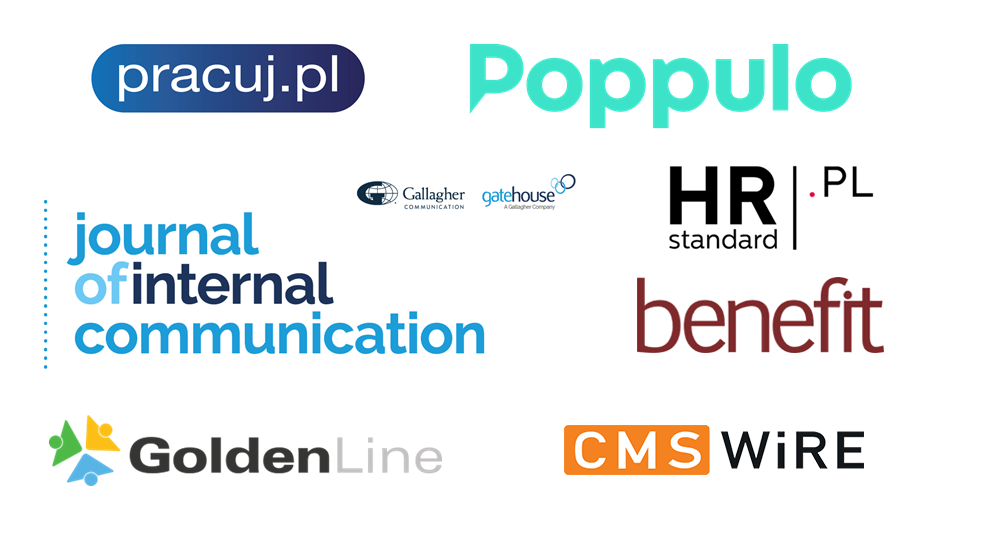

On my blog I present useful tips on how to improve the communication aspect at your companies. This time I would like to focus on modern intranets. I have asked three experts (pictured below) working at Ideo Agency, a Polish Digital Agency, to share their ideas with you. We have prepared a great article with several practical examples and helpful features modern intranets just must have in 2021. Moreover, they want to share with you an interactive PDF entitled ‘Brief for a good intranet’. It will help you collect your ideas concerning an intranet for your company.

Urszula Kandefer, IC expert at Ideo Agency (LinkedIn)

Damian Leszczyński, Senior programmer and IC system architect at Ideo Agency

Łukasz Szymański, Head of Marketing and PR at Ideo Agency (LinkedIn)
Helpful and modern features to include in your intranet platform
For months now, the ongoing pandemic gave companies all over the world, a great push to use digital tools more wisely and on a much larger scale. We can talk about a true onset of digitalisation while running all organisation types. And, although it is just the beginning, it provides all enterprises with an excellent incentive to redesign their business growth strategies.
Business digitalisation is a process that involves internal communication, more than you know. To go ‘digital’ means to apply more remote online tools. Now, they are not just optional measures you try, but simple must-haves. Intranet frequently referred to as a centralized digital workplace, is one of them. So, how should the contemporary workspace look like to fulfil its role and meet all employees’ need? Check our ideas.

To help you collect your ideas concerning an intranet, and get some inspirations, you can use the free interactive PDF prepared by Ideo. You can download it here
CATEGORY: The information search
- Tree organisational structure
Once upon a time, to present hierarchy, companies used simple images or pictures printed directly into a PDF file. Now, the most transparent way to show company org is via an interactive tree organisational chart. Its advantage lies in being ‘clickable’. You can hop onto its tree branches with a cursor. The higher you go and click - you can view who is the company’s president or CEO. By reaching the tree centre, you will know who is department's manager, and who are the team members.
- Employee’s profile
To learn more about an employee, click upon that person on a company tree chart. Let’s say, the person of interest is John Smith. On the tree, we see he is the Head of Accounting with a team of 20 employees. Once we clicked on his persona, the system directs us to his profile. In there, we learn all the basic information about him. In case you’re wondering how it is done - details usually are drawn automatically from the company’s HR system. Info displayed depends on what you choose during the implementation. For instance, it is possible to add a special form where an employee can include such info as personal details, accomplishments, skills or hobbies. Once completed, it is posted, and all company employees can get to know and find a new co-worker.
Let’s say, John Smith is fond of Artificial Intelligence (AI) novelties and has included them in his description. Thanks to a full-text search engine, we can type in ‘artificial’ and the system right away will show us all employees who mentioned that word. A quick, easy, and extremely intuitive way to find anyone in a company.
Modern intranets offer even more features that enable you to view other details on an employee’s profile. Those include, for instance:
• employees present at the office, those working remotely, or on holiday, or a business trip,
• a person assigned to perform an employee’s work duties during one’s absence or a leave,
• business trip details: the client’s name and the trip’s official duration,
• temporary workplace (along with an interactive map) based on Resources Booking System integrated with the company’s internal calendar. For instance, we can learn that a person has got a meeting with a client in conference room no. 6,
• employees’ annual leave plans,
• a specific team or an employee including their supervisor details.
Keep in mind! Intranet features that we have just mentioned are standard ones.
How about the employee’s profile picture? In most organisations, it is simply obligatory to import one’s picture during completing or updating one’s profile. Most employees are unwilling to add their image to the Employee Database. To encourage employees to do so, you may think about running a promotional campaign or even organising an internal competition (with special prizes). You can also consider designing an onboarding process where completing a profile is a part of it.
Adding a picture by any employee and completing an employee’s profile with data has an irreplaceable value to the company in the long run. Why is that? First, you match ‘a face to the company’, you may not know the person’s name, yet somehow you know they are a part of the same company. It matters a great deal in a regular office setting. Also, during ‘remote work’ mode makes it less intimidating when you can give a person from your contact list a ‘face’. For multi-branch organisations and companies with hundreds of employees, it may become a challenge, however, the solution to it is that simple.
- Intranet search engine to find employees, articles, and documents
The efficient search engine is a key intranet feature. Not just during the pandemic, or remote work, or while being at the office. Easy and quick access to documents and other company resources should be always any company’s priority. It should include employee’s search engine and enable them to search for their co-workers or find out to whom they can turn to solve any situation.
Another powerful feature, you just need in an intranet engine is a full-text search. Yet, what does it mean in practice for you and your employees? Once you type in a key phrase in a search field, it gets a few times more hits. The explanation comprises 2 major reasons. First, the search ‘hunts for’ the key phrases within the intranet content, i.e., the published content (file names, titles, text). Second, it literally ‘combs through’ any files content itself within supported extensions. The most common ones used at any office are, e.g., .docx, .xlsx, and any PDFs. Once you find what you’re looking for, it can even highlight for you the key phrases in a text passage.
Sometimes, you may want a search engine that needs to be more accurate than others. The one which can find multiple word language variations: their endings, or single or plural forms, or even tense type in the entire database. The best ones even have a built-in auto-populate mechanism or a drop-down list to make the search easier and convenient.
Organisations collect large data volumes. Some of it, you can qualify as confidential, and thus access will be limited. Role and rights system may just be the remedy for your headache. By assigning each employee a user role in your organisation, you can control what intranet information they can view, edit or even publish. For one, managers have additional tasks, hence their privileges, and rights within the intranet platform will reach much further. Naturally, they can access sensitive data, while the same content will remain invisible to other team members.
Any expert will tell you that the best intranet feature is, in fact, a reliable search engine. You can have the best content, however, if employees cannot reach it - it simply becomes useless and obsolete. Make sure the intranet search browser works well and genuinely benefits all company employees.


Source: All images come from ideogency.com
- Up-to-date content database, archives, document repository
Everyone knows that the company’s archives are a mine of valuable knowledge. Also, everyone knows the information is precious and needs to be well-protected. What we often forgot about is protecting it from being wasted or lost in digital chaos. Here, treating it well means keeping it organised and accessible to everyone. Start by setting up standard rules for adding and keeping files in a database. For instance, decide upon rules on naming files or saving them in common extensions. Make sure you include the posts’ authors, so later on if needed, intranet users can get in touch with them.
It is equally important to update a document and have control over its historical changes. This is what you call versioning, and it’s not just about viewing changes yet, even re-instating documents’ previous version (if needed).
Another interesting intranet feature, you’ve surely heard of it, it’s the OCR (Optical Character Recognition). It enables to extract quickly the text from any image without retyping it over and over. After scanning it, you get the text itself, so you are free to change it in any way you want, and rapidly publish on the intranet. No rewriting the same content, that is genius! Text goes into the database straight away. Also, the whole content is visible to the intranet full-text search engine.
When Ideo worked with a client, Provident, they included constant update notifications for intranet content, e.g., especially posts. The implementation involved programming an automated notification email sent to posts’ authors. At regular intervals, the email template would ask the author whether the content is still valid or void?
Let’s say the author did not confirm or respond to that notification. At the top of that post, all intranet users would see the following warning: Updated on 22.05.2017 The post maybe not valid. Let the author know.

You can build your company’s internal document database in various ways. One way of doing it is dividing it into blocks, where each one corresponds to a specific category or a theme. In our example, the Helpdesk section therefore would include all matters concerning that topic.
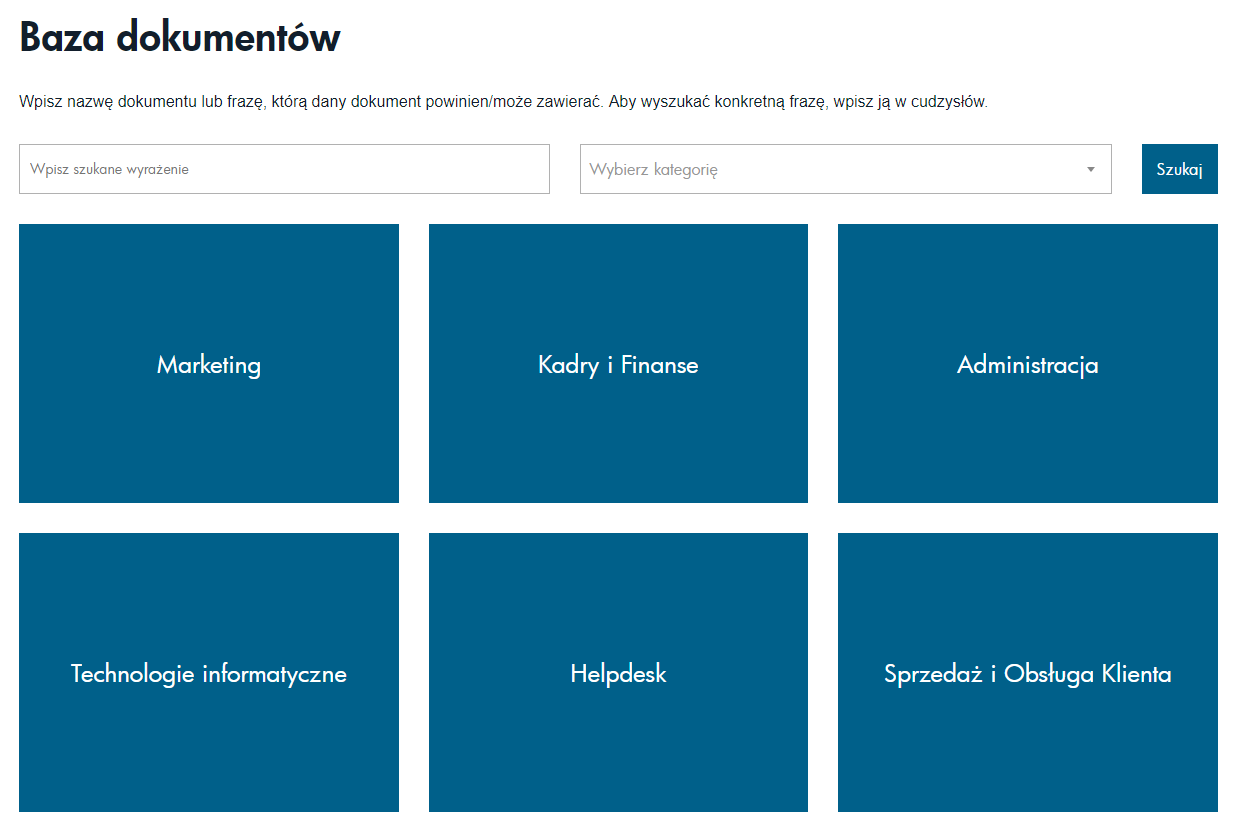
Once someone enters that block will see a search engine and a files list with additional details, e.g., name, its file extension, publication date, and others. Some items will be available for download. Including the search engine at the top has its practical purpose. Employees can type anything they need and find the content quickly, and with ease. Just like the Helpdesk section in the screenshot below.

By default, the system limits post-editing to authors themselves. However, in our intranet system, you can simply change it by setting up different editing rules. Similar to the one Wikipedia has. If a person spots an error or discrepancy in a text, one can alter it at will or report it. In the latter, the author receives an email verification request. Depending on your system’s editing settings, you can view the full history of all changes.
- Company current events calendar
Nowadays, everyone uses a calendar of some type. Even a simple company calendar proves to be an efficient feature in any organization. Scheduling all company events, meetings (internal, client-related), conferences improve overall the communication between employees. You can also plan other important tasks such as billing, where time is of the essence. Fixed dates marked on a calendar for training or engagement surveys can boost employees’ morale well enough.
The centralised calendar has even more potential. You can inform your organisation about a new company newspaper, internal comms audit, or launching a newsletter. Usually, it is a great idea to assign specific employees to edit the company calendar. Making changes is not only simple but instant. And, since the calendar is visible from each employees’ intranet home page, they will learn about all news right away.
In your company, you can have several calendars apart from the official one. Sometimes it might be useful to loosen up the company environment by adding a social calendar. In there, intranet users can see other events such as concerts, exhibitions, or events for kids. Don’t be fooled. It is vital for the spirit of your company community. By doing so, intranet users report and create their calendar events, that others may find valuable. Engaged employees are simply happier employees.

Company events in November (Intranet Calendar)
CATEGORY: AVAILABILITY
- Personalised home page
We find that the best modern intranets strongly focus on personalisation. The employees’ intranet homepage is an excellent place to start. Personalising the content means the intranet users decide for themselves what is worth their attention.
For example, in the Provident’s intranet platform all employees can determine their areas of interest and news about other departments. To keep them updated, Ideo set up for Provident content e-mail notifications they wish to follow.
For Empik’s intranet implementation, the company went even further - employees can design their intranet homepage layout. Some elements are default and display obligatory info for all. Yet, most of them, they can arrange according to their personal preferences.
Here, we show a sample mock-up for the intranet homepage.
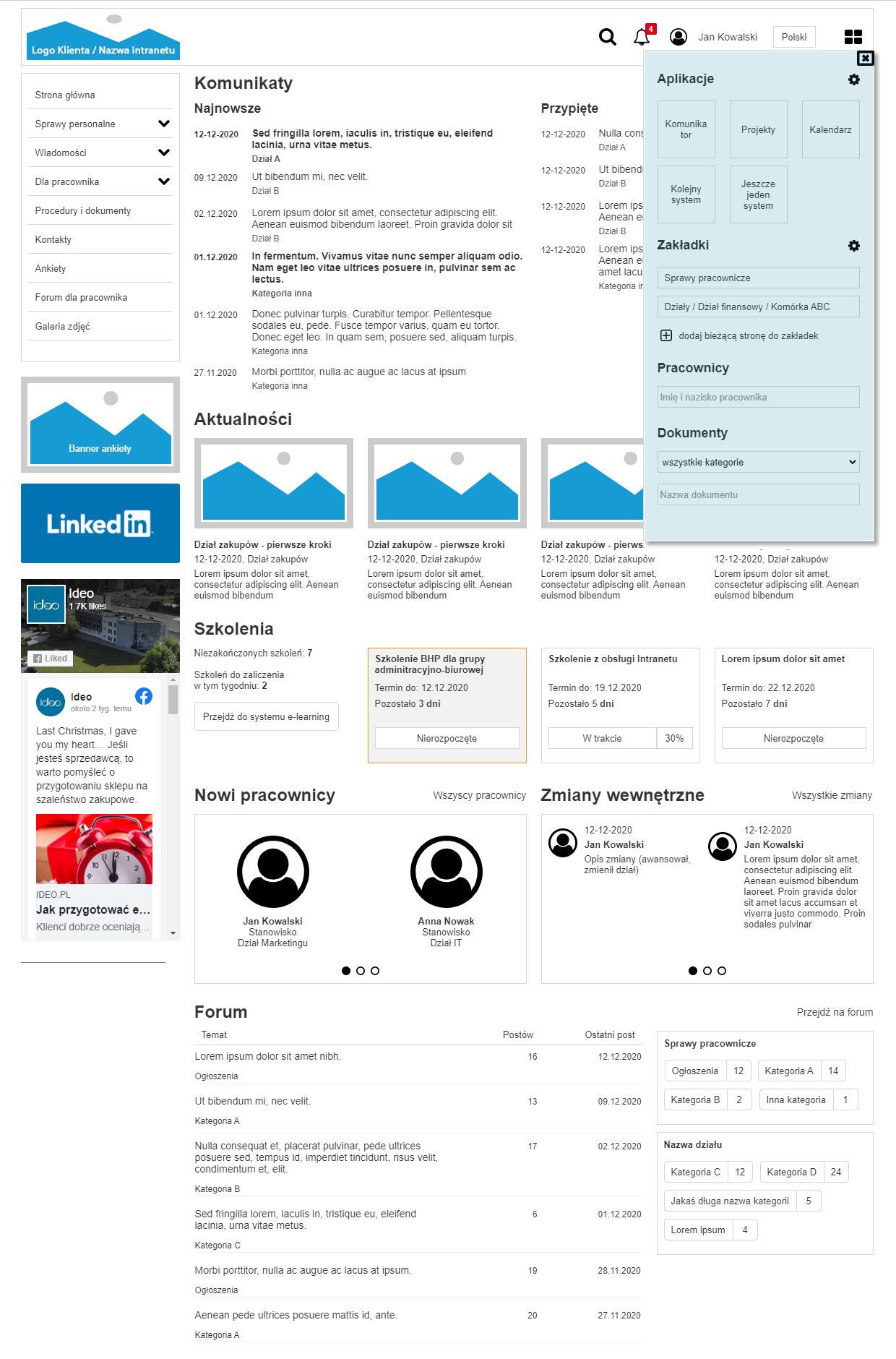
Planning its layout is the first vital step during intranet design. It involves thinking through the placement of obligatory and personalised elements and their overall arrangement on the page. Make sure you plan the content from top to bottom. While doing so, you need to consider correlations between all elements on the page to keep it transparent and coherent. Once, the design is ready, and only then, you can hand it over to your graphic designers.
- Provide mobile access
Within the last 3 decades, mobile devices rocked our world and replaced standard PCs. Why shouldn’t you offer intranet access to your employees via a mobile device? To do so, you have 2 choices: a website in an RWD technology or via a bespoke application. The first option is about maximum responsiveness and adaptation. RWD lets users interact freely with the website without it getting stuck. It adapts to devices’ screen size and its resolution. RWD-based website makes sure the users see the content in the right way and not all scrambled.
Some company data and content we should protect more than others. Thus, before making it available on the mobile (i.e., outside the company’s network), consider to which category they fall, and what intranet user groups should have access. The same goes for intranet features - some are necessary while others are not. While dealing with any confidential company data on a mobile device, provide additional security measures.
Nowadays, internet access is not such much a privilege as a right, the intranet access is becoming a new standard for organisations. The pandemic outbreak and economic restrictions will significantly speed it up.
Putting these grand reasons for intranet access aside, there are also the ones we experience daily. For instance, recall a meeting, when you needed a specific set of company data - at that exact moment? If you only could grab your phone, log into the intranet, and find out in a matter of seconds. Or let’s say you are a salesperson. You could right away jot down all vital points, issues, or notes you discussed with a prospective client. Wouldn’t be just easier to do on the spot, rather than come to your office?
Intranet with a built-in DMS (Document Management System) connected with a workflow mechanism provides way more benefits to your employees than you can imagine.
For example, having that access enables them to submit a vacation form, enter an invoice into the company system. Heads of departments, or L1, 2, or 3 managers, get instant notification about these events and can either accept or deny it. After doing so, the approval process is only quicker but more convenient.
There is also a bespoke module for project management. With a few clicks, project managers can quickly delegate tasks to other employees, or order to issue an invoice. If your head is already spinning, there are even more possibilities. We just wanted to provide an insight on how you can optimise your company’s work and unburden your employees.
- Standard and push notifications
You can improve IC in your company by sending standard or push notifications about newly published posts on the intranet. The idea is to grasp the intranet users’ attention and encourage them to follow the new content on the platform.
You can choose from the automatic e-mail notifications, brief messages, or a notification icon showing up every time there is a new entry, task, post, or document requiring their immediate response. Introducing such a feature in your company will guarantee that your employees will not miss out on any important news or a decent article. Our expertise has shown that intranet users are very fond of them, especially if they find them useful.
Receiving notifications can encourage users to take a sneak peek at what is the intranet tool and may make them use the tool more often. However, if there are too many notifications, with time intranet users will begin to regard them as an ‘interactive’ SPAM and will ignore them. It doesn’t have to be like that. If you can personalise your homepage, you can do the same with any notification type and its frequency. Companies are fond of such solutions, and so we are. So, remember to keep it on your intranet features to-do-list, even if you decide to keep it on your back burner for now.
What about the notification text messages? That is another way to go. It may be just the right choice, let’s say when you need to pass urgent information or get in touch with other employees to avert a crisis, or during a pandemic outbreak.

The notification system in the Provident intranet (source: ideoagency.com)
CATEGORY: DIALOGUE AND COOPERATION
- Comments and quick ‘likes’
Enabling employees to add comments enlivens the intranet and allows everyone to express their opinions. Not all employees, despite using an intranet frequently or viewing posts, will engage in commenting on the forum. It is especially true with any company’s content type. However, we insist you don’t give up and still introduce that feature, and here is why.
Commenting on entries or posts via emojis (e.g., hearts, smileys, thumbs up, frowny face) is an alternative way of posting comments. It proves to be extremely successful not just in the social media context but among intranet users. Even though there is no direct exchange with employees, it leads to an interesting form of interaction.
The number icon by an entry or a post can help you collect data on how many people displayed an entry or what type of content is popular. It supports the idea: strength in numbers. The more views a post gets, it motivates others to follow and see it as well.
To increase intranet user engagement rate, consider introducing a scoring system. You can reward more active employees with additional scores for posting various content. Your intranet will get more of a social media feel, yet still in a workplace.
- Forum and wikis way to spread knowledge and share information
Unfortunately, any research shows that enterprises often neglect the IC and knowledge management. For unknown reasons, it has always been at the bottom of the to-do-list. However, until recently, partly because of pandemic, it has become one of the vital aspects to run a modern business.
Each team member possesses specific knowledge, expertise, and a set of unique skills. It is painful to watch how that value wastes away, by keeping it on a computer drive or to oneself. Intranet can be a tool to release and open up that information to everyone in a company.
Exchanging knowledge and sharing experiences enriches and benefits the entire organisation. Providing employees multiple opportunities to exchange knowledge and share experiences benefits everyone and help to become a modern enterprise. Within each organisation, you can spot at least a few enthusiasts who, if get a chance, will be happy to publish on the company’s online blog. It is especially visible now, in the pandemic reality, where most of us work remotely, and interact with each other solely via online channels.
CATEGORY: TASKS
- Use a secure internal file transfer
Transfer of sensitive company content or data requires the most secure solutions. You can use external tools such as WeTransfer platform, however maybe not worth it. Choosing the intranet built-in transfer tools is your best bet. In Provident intranet, the Ideo company implemented a self-sufficient module for exactly that purpose. Any employee can transfer even high-volume files. After some time, the system automated algorithms delete them.
You might ask: why can’t I just send files via email as an attachment? Unfortunately, it is not always possible. Mail servers have certain limitations, just like the voicemail had. They exist to prevent blocking the entire mailbox.
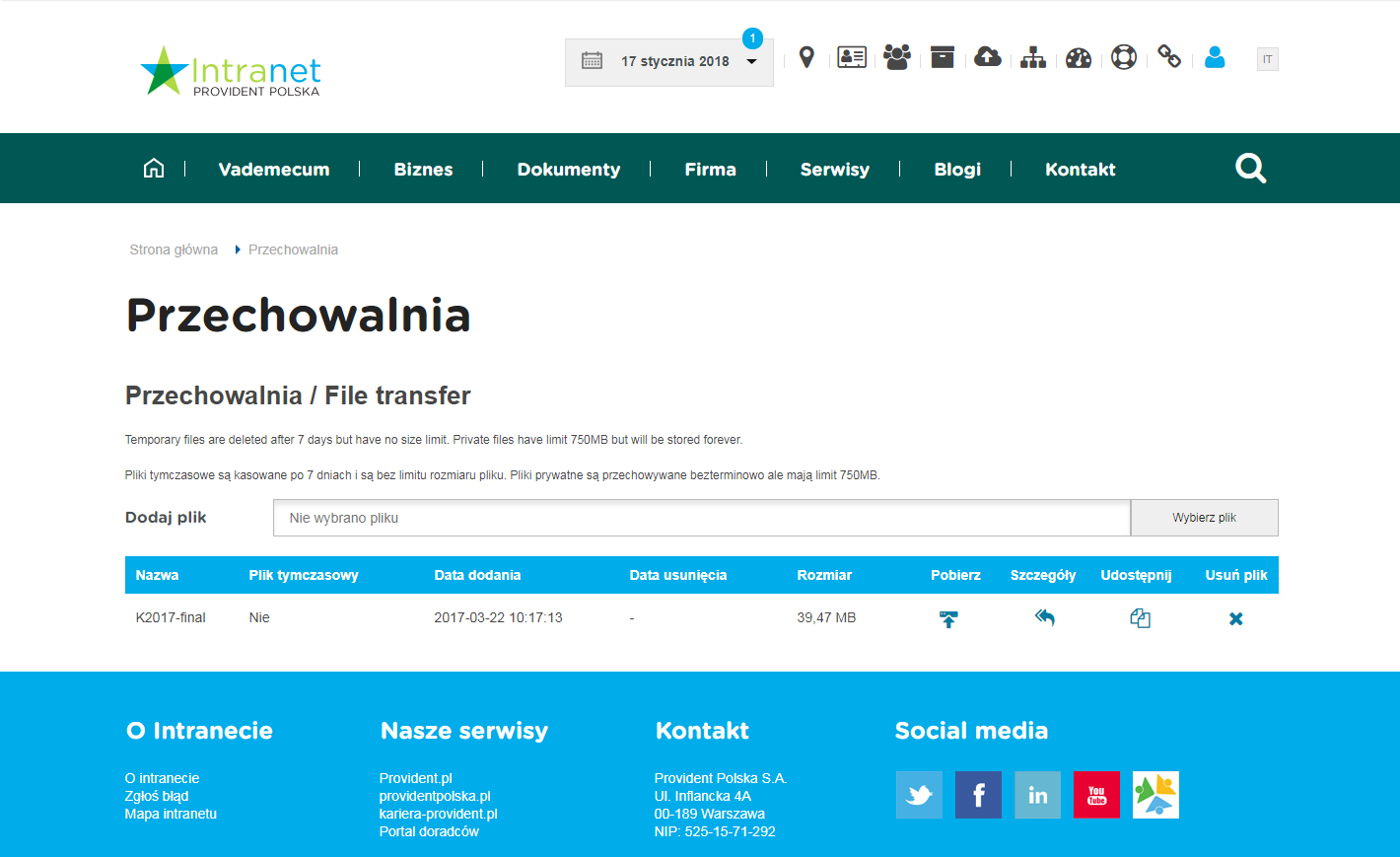
Internal storage and transfer system used by Provident employees
- Resource booking
Each company has resources available for employees to book, to perform their daily work tasks. Now, most employees work for home so the demand for projectors, conference rooms or company car has significantly dropped.
However, the pandemic will end, so it’s best to consider now how to manage your company’s resources more efficiently in the future.
Why should you ask? For one, it gives you more control over your company’s assets and optimises the workload related to their management. Include the resource booking feature in your intranet. Possibly, you can request your employees about resources they would like to book online. Modern intranet enables even more advanced options, such as hotel room reservations or signing up for any type of training or workshop.

Provident intranet - registration form for a company event
- Online forms to deal with issues
Implementing electronic forms into the intranet platform can serve your company very well. While planning what type of forms, your employees would appreciate is better to collect their feedback. A lot of matters, they can solve via submitting an online form.
Even though digitalisation has recently gained momentum, it is still not possible to handle most things via online channels. For that reason, some of us resent it and cannot understand why. A similar situation presents itself in companies. If we can shop online, pay our bills via credit wallets, why shouldn’t we able to go about formal company tasks the same way?
Having included these features in an intranet platform, e.g., submitting a vacation form, settling accounts, sending invoices to a client should be a piece of cake from now on. Remotely, it is possible to keep the company’s workflow intact and keep working as usual.
With a modern intranet, there is always room for improvement. For instance, during submitting a vacation form, you can add a person taking over your duties during your absence. If you want to know, if someone is out of office, just look at the employee database. Right away, you will know who has a two-week vacation, and who is their deputy. It proves to be useful, especially while managing ongoing projects. Knowing that immediately lets you get in touch, discuss a project or help with some issues. No more playing a detective to find that person and wasting your precious time!
- EDMS Workflow & Contracts and service billing database
With the technology we have at hand, printing docs and getting signatures is not something you and your employees cannot do without. You would be better off. Traveling to sign a contract or get one’s approval does not match today’s rapid business world. There is an alternative way to get the job done well and in no time. Electronic Document Management System combined with the workflow feature enables you to gain control over the entire process.
Send contracts and invoices electronically, and someone on the other side will approve them in your company’s system. Also, the document processing status is visible and is being updated constantly. If something happens, you can reverse it and go back to the previous step. Or if someone is procrastinating, you can get a hold of them and motivate them to work on that document.
You save the precious time you would waste on traveling to another branch. Reduce the financial cost of document delivery by courier. Workflow EDMS and Green Policy go hand in hand, you benefit your company and our planet.
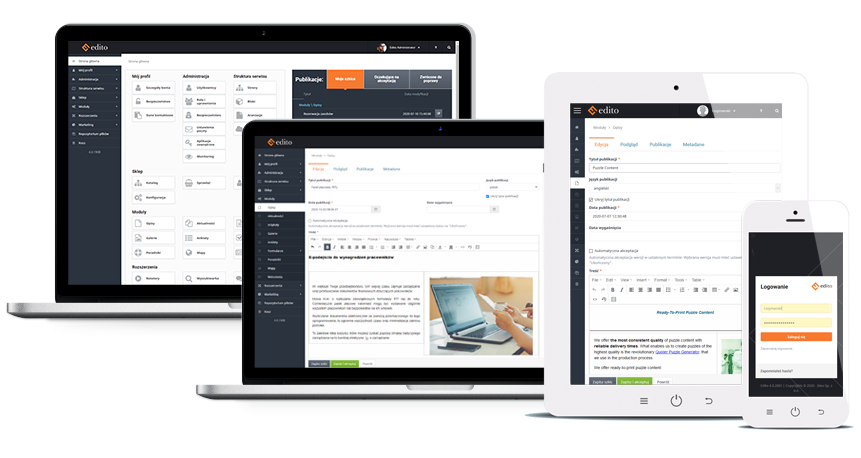
LOGITO - Ideo’s proprietary EDMS platform
- Help desk
Reporting any employee issues or sending inquiries can become a part of the intranet platform as an Employee Help desk. You can do that with any IT issues or inquiries to specific teams. After submitting tickets, employees can monitor their ticker status within the company’s system. You may think it sounds like a lot of work, however, implementing such tools can be trivially simple.
For instance, it is possible to integrate an already designed help desk module and even include bots for additional support. You can extend your current platform or include it while designing your new intranet.
- Quick access to various company systems from intranet’s homepage
During the intranet implementation stage, companies want to use various software, platforms, and system - each one to deal with a various set of tasks or issues. Sometimes, they come from a variety of suppliers, and it requires employees to log in individually. It is okay, but an extremely inefficient approach.
To facilitate that quick access, you can insert on the homepage a ‘Links database’ table. The name itself is self-explanatory, however, you can call it ‘favourite links’ or even get more creative, e.g., ‘house of links’. By clicking on a system’s shortcut, an employee logs automatically onto that platform quickly and easily. By adjusting the home page appropriately, you get your employees their navigation centre. Be sure your employees will enjoy that simple solution and start using the intranet more frequently.
- Links Database
The links database should always be visible and have a fixed position on the homepage. It is common to put it on the page side, so it does not block the content in the centre. Again, the intranet users can personalise it by changing shortcuts’ order or adding the ones they use the most. The more systems you use at your company, the more helpful the section will be.
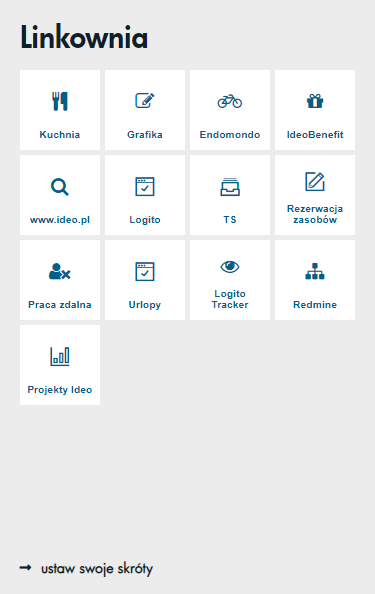
- KPIs Preview
It is useful to display various types of statistics or rankings, e.g., your company’s KPIs (Key Performance Indicators). It provides a quick insight into the sales percentage results in a defined timeframe. The feature will be especially helpful to sales managers or employees who are working on these tasks.
All you need to do is to integrate the preview with your CRM or other systems you use. The system will collect that data daily and display it in the KPI Preview on the intranet. We call these solutions real-time dashboards. If your company introduced the gamification approach, you could apply it that way too. Employees will willingly follow and check score stats on the intranet. You can include hints on how to get more points to become a leader.
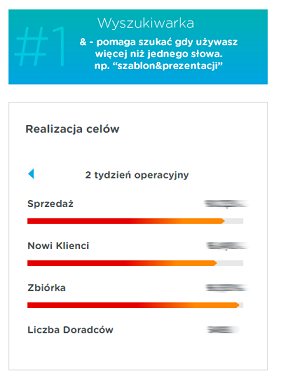
Provident’s Intranet: KPI's business goal covering two weeks. Extra block with hints on how to use the intranet search browser
CATEGORY: Intranet features for IC Specialists
- Opinion polls via questionnaires, and surveys
On the market, you will many external and cost-effective opinion poll tools to use. In our opinion, the internal ones may just be a safer option. Simple polls you can prepare directly in such a tool without having to worry about any data leakage.
However, if you need to create a more complex survey, one for, e.g., the internal communication audit, we suggest using an external one as they are secure and professional. Also, the employees see them as more impartial, which means intranet users remain completely anonymous.

For example, DPD company organised a competition among employees to select the best company’s intranet name. Such an initiative is great for promoting the tool itself and engaging employees. Also, it provides a great opportunity to show the intranet users how the internal polls and survey work in real-life.
- Automated internal newsletters
Make your work easier by adding that feature to your intranet platform. Now, it is common to implement, so-called a newsletter. It is an excellent choice to keep informed those employees who don’t use or view the content intranet frequently. Via an automated push newsletter with essentials, we can keep them informed.
Automation enables us to send the newsletter automatically at a specific time and date. Also, the newsletter editors can create it quickly by marking specific entries. Afterward, the newsletter feature will generate it in, e.g., a printed PDF. If something is missing or incorrect, it is possible to add new content or edit the one that is already there.
- Obligatory statistics
Intranet without statistics? There is no such option! Measuring communication is mandatory. Make sure that your systems have such a module. Also, look there often, and determine in advance, which indicators will be satisfactory for you. Statistics are a mine of knowledge about effectiveness, but also a litmus paper for finding out employees’ interests and needs.
For example, frequent search for one document does not mean it is very useful. Quite the contrary, it may mean it is in the wrong category. Employees search for something else, meanwhile, they get that specific file. The document may simply not exist.

Having access to advanced statistics and data analysis tools on the intranet is equally important and, in fact, obligatory to improve the IC. They are also any IC specialist's best friend to comb through the data and solve issues.
Including the historical search, the browser can partly fall in that category. It is a tool that gives us hints on what employees search on the intranet.
- CMS that works like a charm
Last, but not least, choose an intuitive and relatively easy to use Content Management System to manage your intranet and the digital workplace. Once you get a hang of it, it will speed up building up your intranet. It will help you make it your company’s intranet by publishing articles, posts and enriching it with videos and photographs. Using a simple, yet adequate text editor should enable you to all things you want (almost like Word).
Remember about designing a fairly transparent workflow for publishing, editing content or moderating comments. Assigning permissions to system users is a vital part of keeping the intranet chaos-free. Some people may create and add new content, under the condition, the authoriser accepts these entries or changes. Before that happens, a post will be ‘waiting’ for publication, visible merely to the author and its authorizer. It is possible to appoint several authorizers for the same content.
Sometimes, it’s needed that page or pages require attention from over one person, but an entire team. Then, you can form a group to work on several pages. To make it more efficient, during editing each member can add comments for the others to see. It works just like the Word review tool - Tracking.
In this article, we have covered aspects that are merely a solid basis for building a modern intranet platform. If you’re considering any new intranet implementation or intend to expand your intranet features, it is worthwhile to examine every single one.
As promised, here is the BRIEF FOR GOOD INTRANET from Ideo. It is free for you to download.
It is not just a regular PDF document you will read and forget all about it. It can serve you in several situations. It is useful, before you sent an inquiry to a prospect IT supplier, as it provides an insight into what’s required to know prior to an intranet design. It can guide you and generate ideas on how to improve your intranet platform.
Even if you are a novice, when it comes to intranets, it defines your company IC needs and IT requirements and compares it when you’re at.
What else can you do with it apart from reading reviewing it? To tell you the truth, lots of things. It has a contents table, so you can go to any specific section in a PDF.
Since, it’s interactive – you can check boxes, fill out with longer answers (text fields expand), add comments and save all the changes. Once, it is done – share it with other people in your organisation who can do the same. The form itself changes into a data consolidation tool. After that, you’re in a perfect place and ready to start talking about the IC business within your organisation and IT suppliers.
After all, we all share the same goal. Everyone wishes for an efficient company with splendid internal communication. With such a tool like an intranet – pleasing to the eye and useful for employees, your destiny is an inevitable success.
******
Join me on:
• Facebook @behindtheicscenes
• Twitter @maja_biernacka
• LinkedIn
Graphics: Ideo

